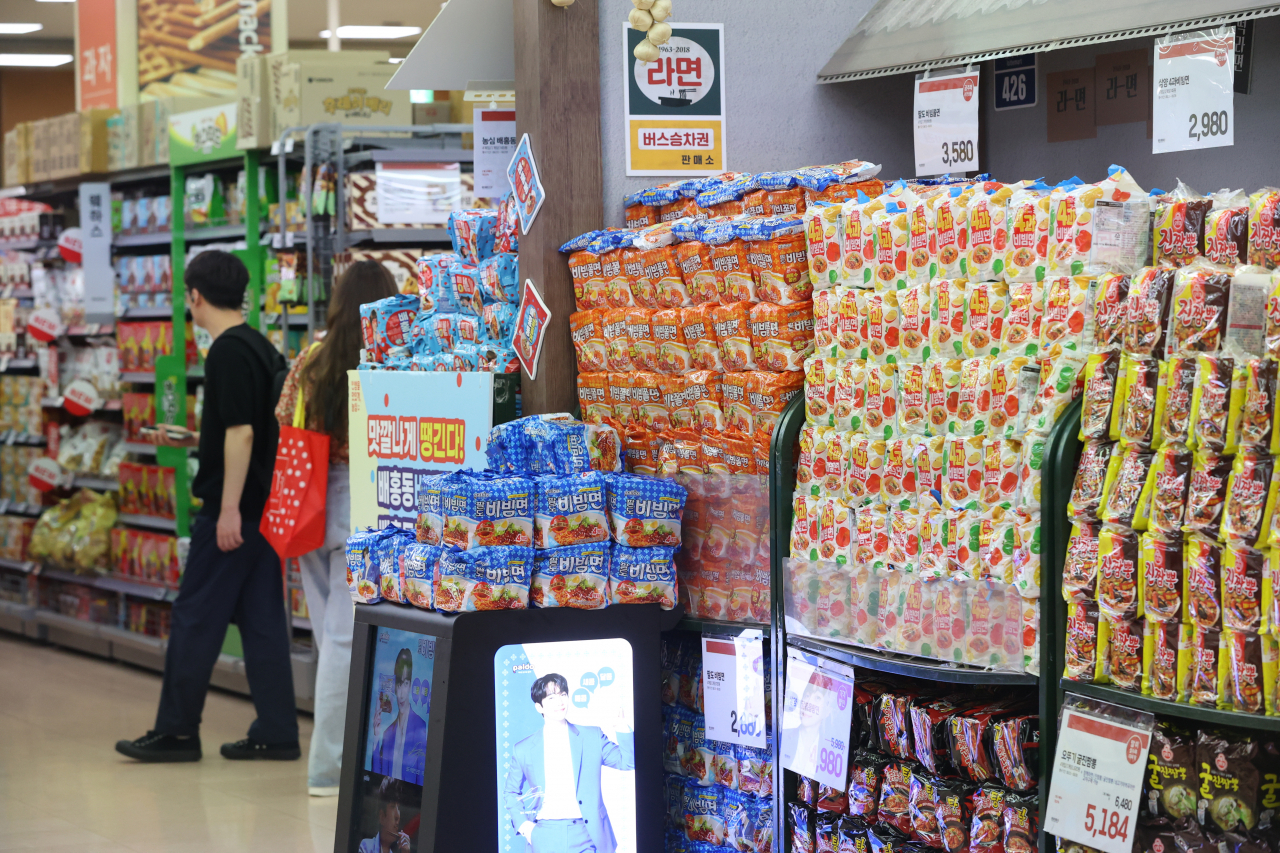 |
Packs of ramen are put up for sale at a large discount store on Wednesday. (Yonhap) |
South Korean ramen manufacturers are in a rush to cut prices of their flagship ramen and snack products, following the government’s pressure to lower prices of daily necessities.
But Samyang Foods, the nation’s second-largest ramen maker, cannot lower the price of Spicy Buldak Ramen, a bestselling product that now sells better overseas than at home. In the January-March period this year, the instant noodle made 163 billion won ($124 million), or 66 percent of the company’s quarterly sales, making 77 percent of its sales abroad.
“Its domestic sales are directly linked to its global sales. If we were to lower domestic prices, several adjustments should be made to the product’s international retail and wholesale prices,” a Samyang official said. “We also cannot ignore our global consumers’ reactions to the difference in prices between at home and abroad.”
Fueled by the growing popularity of Korean culture around the world, Korean ramen has also become a key export item in recent years. In the first quarter this year, its exports soared to a record $280 million, according to Statistics Korea.
After years of global expansion in recent years, however, local ramen makers, arm-twisted to lower their domestic prices, are being pressured to review their pricing policy overall.
Nongshim, the nation’s top ramen maker, is also in the midst of discussing adjusting the international prices of Shin Ramen, whose global sales make up some 44 percent of its total annual sales.
“With the cut in our Korean prices, discussions began for our exports and goods produced overseas to change prices,” a Nongshim official said, declining to further elaborate.
Industry officials admitted that the latest price cuts at home may have a limited impact on their global sales immediately, but added they feel confused about the “inconsiderate” demand from the government.
“The situation would be better for companies with overseas production plants, which allows more room for their pricing policy,” said an official of a ramen company on condition of anonymity. “But companies that solely depend on exports for overseas business are feeling the pressure.”
He said many of the companies seem to be leaning toward retaining their global prices for now.
“If there are further pressures to cut prices, they have no other option but to lower their global prices, which will lead to a decrease in profits both at home and abroad,” he said, adding that the profit gap between companies with local production facilities and those without them could be widened in the long term.
Since last Tuesday, a day after the government agreed with the nation’s milling industry to lower wheat prices, a slew of the nation’s top ramen makers have cut the prices of their flagship products by an average of some five percent. Nongshim, the market leader, lowered the retail prices of its popular ramen and snack products including Shin Ramen by an average of 5.2 percent, while other leading companies such as Samyang, Ottogi and Paldo followed suit.
“It’s impossible resist to government pressure,” said another official from a local ramen firm who also wished to be unnamed. “We have to show support for the government’s decision to curb inflation, and also have to maintain our price competitiveness among rival products.”
Experts, however, remained uncertain about the actual impact of the coercive government policy.
“Product prices are determined by demand and supply, not by the government,” said Seok Byoung-hoon, an economics professor at Ewha Women's University. “Upping the pressure on companies could lead to consumer damages in the long term.”
According to Seok, ramen has low price elasticity, which means even price cuts have little impact on its demand.
“Regardless of price cuts, consumers won’t buy more of it. This will lead to a significant drop in their makers’ financial performance,” he said.
“For instance, Nongshim said it could reduce operational costs by 8 billion won due to lowered wheat prices, while expecting its price cuts to generate more than 20 billion won of direct benefit for consumers. This means the company will soon be seeing some 12 billion won in operational deficit. This, in return, will inevitably lead to a price hike to offset the losses.”
He stressed if the government wanted to effectively curb the inflation rate, they should have given enough time for companies to gradually tweak the prices of the overall retail chain, including labor costs, utility costs and other minor costs such as packaging and logistics.





![[Herald Interview] How Gopizza got big in India](http://res.heraldm.com/phpwas/restmb_idxmake.php?idx=644&simg=/content/image/2024/11/20/20241120050057_0.jpg)

